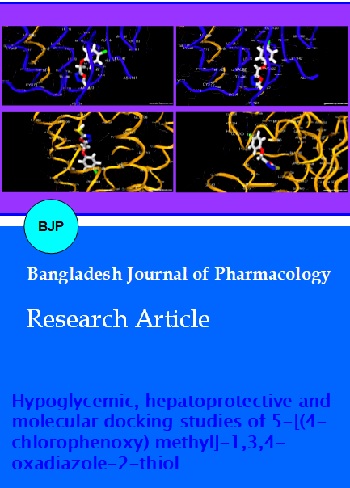Hypoglycemic, hepatoprotective and molecular docking studies of 5-[(4-chlorophenoxy) methyl]-1, 3, 4-oxadiazole-2-thiol
DOI:
https://doi.org/10.3329/bjp.v13i2.35514Keywords:
Hepatoprotective, Hypoglycemic, Molecular dockingAbstract
The present study aimed at the evaluation of anti-hyperglycemic and hepatoprotective potential of a new drug candidate, 5-[(4-chlorophenoxy) methyl]-1,3,4-oxadiazole-2-thiol (OXCPM) through in vitro and in vivo assays, respectively. The compound displayed excellent dose-dependent ɑ-amylase (28.0-92.0%), ɑ-glucosidase (40.3-93.1%) and hemoglobin glycosylation (9.0%-54.9%) inhibitory effects and promoted the uptake of glucose by the yeast cells (0.2 to 26.3%). The treatment of the isoniazid- and rifampicin- (p.o., 50 mg/kg of each) intoxicated rats with OXCPM (100 mg/kg, p.o.) resulted in restoring the normal serum levels of the non-enzymatic (total bilirubin, total protein and albumin) and bringing about a remarkable decrease in the levels of enzymatic (alanine transaminases, aspartate transaminases and alkaline phosphatase) biomarkers. The molecular docking studies indicated high binding affinity of the compound for hyperglycemia-related protein targets; fructose-1,6-bisphosphatase, beta2-adrenergic receptors and glucokinase. The results indicate that OXCPM may not only reduce hyperglycemia by enzyme inhibition but also the disease complications through protection of hemoglobin glycosylation and hepatic injury.
Video Clip of Methodology:
Glucose uptake by yeast cells: 4 min 51 sec Click to watch
Downloads
200
155 Read
27

Published
How to Cite
Issue
Section
License
Authors who publish with this journal agree to the following terms:
- Authors retain copyright and grant the journal right of first publication with the work simultaneously licensed under a Creative Commons Attribution License that allows others to share the work with an acknowledgement of the work's authorship and initial publication in this journal.
- Authors are able to enter into separate, additional contractual arrangements for the non-exclusive distribution of the journal's published version of the work (e.g., post it to an institutional repository or publish it in a book), with an acknowledgement of its initial publication in this journal.
- Authors are permitted and encouraged to post their work online (e.g., in institutional repositories or on their website) prior to and during the submission process, as it can lead to productive exchanges, as well as earlier and greater citation of published work (See The Effect of Open Access).
